The Development of a Web-Based Training Package on Reading Strategy Instruction for English Language Teachers at Secondary Education Level
Main Article Content
Abstract
The purposes of this research were to 1) develop a web-based training package on reading strategy instruction for English language teachers at secondary education level, and 2) study results of experimenting with the developed training package. The samples comprised 33 English language teachers in secondary schools under the Office of the Basic Education Commission voluntarily participating in the training. The employed research instruments were (1) an evaluation form for quality assessment of the web-based training package, (2) a web-based training package, (3) a test on knowledge and understanding of reading strategy instruction, (4) a teacher diary for reflective thinking on learning management, and (5) a scale to assess the trainees’ satisfaction. The data were analyzed using the mean, standard deviation, t-test, and content analysis. The research results were as follows: 1) The developed web-based training package on reading strategy instruction for English language teachers at secondary education level consisted of 2 innovations: a web-based training package and a manual. The experts evaluated the overall quality of the training package and the manual at the highest level. 2) The post-training mean score on knowledge and understanding of reading strategy instruction of the trainees was significantly higher than their pre-training counterpart mean score at the .05 level of statistical significance. The information from the trainees’ diary on learning management revealed that they were capable of conducting the instructional activities based on the concept of reading strategy instruction. They achieved their teaching goals, had understanding and confidence in teaching, and realized the benefits of reading strategy instruction. In their view, the weakness of reading strategy instruction did not arise from the instructional problems, but from the teachers themselves as they reflected that it took time to prepare a lesson, to understand the strategies, and to procure additional media. Moreover, the teachers rated their satisfaction with the training package at the high level.
Article Details
References
เกร็ดทราย วุฒิพงษ์. (2559). การใช้ชุดฝึกอบรมบทเรียนอิเล็กทรอนิกส์ เพื่อเสริมสร้างทักษะภาษาอังกฤษด้านการออกเสียง การอ่านและการเขียนต่อความสำเร็จ และแรงจูงใจของครูระดับประถมศึกษา. วารสารปาริชาต, 29(1), 216-242.
เชษฐา ทองยิ่ง (2559) . ปัญหาครู:ปัญหาที่รอการปฏิรูป. สืบค้นจาก http://library2.parliament.go.th/ebook/content-issue/2559/hi2559-091.pdf
ถนอมพร (ตันพิพัฒน์) เลาหจรัสแสง. (2545). Designing e-learning หลักการออกแบบการการสร้าง เว็บเพื่อการเรียนการสอน. กรุงเทพฯ: อรุณการพิมพ์.
ทวีวัฒน์ วัฒนกุลเจริญ. (2558). หน่วยที่ 8 ชุดการสอนด้วยคอมพิวเตอร์ผ่านเครือข่าย. ใน เอกสารการสอนชุดวิชาสื่อการศึกษาพัฒนาสรร หน่วยที่ 1-8. (พิมพ์ครั้งที่ 1, น. 8-1-8-54). นนทบุรี: สาขาวิชาศึกษาศาสตร์ มหาวิทยาลัยสุโขทัยธรรมาธิราช.
มณีรัตน์ สุกโชติรัตน์. (2555). อ่านเป็น: เรียนก่อน สอนเก่ง (พิมพ์ครั้งที่ 4). กรุงเทพฯ: นานมีบุ๊กส์พับลิเคชั่นส์.
สถาบันทดสอบทางการศึกษาแห่งชาติ. (2562). สถิติ O-NET ย้อนหลัง. สืบค้นจาก http://www.niets.or.th/th/catalog/view/3865
สพฐ. เร่งสร้างระบบข้อมูลกลางลดภาระครู. (20 สิงหาคม 2561). เดลินิวส์ออนไลน์. สืบค้นจาก https://www.dailynews.co.th/education/661555
อารีรักษ์ มีแจ้ง. (2560). การพัฒนาชุดฝึกอบรมผ่านเว็บเรื่อง การสอนภาษาอังกฤษแบบบูรณาการทักษะสำหรับครูผู้สอนภาษาอังกฤษระดับมัธยมศึกษา. วารสารศึกษาศาสตร์ มหาวิทยาลัยนเรศวร, 19(4), 110-131.
Anderson, N. J. (1991). Individual differences in strategy use in second language reading and testing. The Modern Language Journal, 75(4), 460-472.
Auerbach, E. R., and Paxton, D. (1997). It's not the English thing: Bringing reading research into the ESL classroom. TESOL Quarterly, 31(2), 237-261.
Barnett, M. (1989). More than meets the eyes. New Jersey: Prentice Hall.
Davis, D. S. (2010). A meta-analysis of comprehension strategy instruction for upper elementary and middle school students. (Unpublished doctoral dissertation). Vanderbilt University, Nashville, TN. Retrieved from http://etd.library.vanderbilt.edu/available/etd-06162010- 100830/
Dohower, S. L. (1999). Supporting strategic stance in the classroom: A comprehension framework for helping teachers help students to be strategic. The Reading Teacher, 52(7), 672-688.
Ghirardini, B. (2011). E-learning methodologies: A guide for designing and developing e-learning courses. Rome: Food and Agriculture Organization of the United Nations.
Grabe, W., & Stoller, F. (2002). Teaching and researching reading. Harlow: Pearson Education.
Khan, B. (2009). Web-based training. In M. J. Marquardt (Ed.), Human resources and their development volume II: Encyclopedia of life support systems. (pp.152-185).Oxford: EOLSS Publishers.
Klapwijk, N.M. (2012). Reading strategy instruction and teacher change: Implications for teacher training. SA Journal of Education, 32(2), 191-204. Retrieved from http://www.sajournalofeducation.co.za/index.php/saje/article/view/618/301
OECD. (1998). Staying ahead: In-service training and teacher professional development. France: OECD Publishing.
Reutzel, D. R., Smith, J. A., & Fawson, P. C. (2005). An evaluation of two approaches for teaching reading comprehension strategies in the primary years using science information texts. Early Childhood Research Quarterly, 20 (3), 276-305.
Richards, J. C., & Farrell, T. S. C. (2005). Professional development for language teachers. New York:
Cambridge University Press.
Topalaa, I. & Tomozi, S. (2014). Learning satisfaction: validity and reliability testing for students' learning satisfaction questionnaire (SLSQ). Procedia - Social and Behavioral Sciences. 128, 380-386. Retrieved from https://core.ac.uk/download/pdf/82439568.pdf


